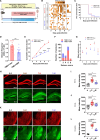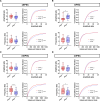Increased expression of chondroitin sulfate proteoglycans in dentate gyrus and amygdala causes postinfectious seizures
- PMID: 38146224
- PMCID: PMC11068111
- DOI: 10.1093/brain/awad430
Increased expression of chondroitin sulfate proteoglycans in dentate gyrus and amygdala causes postinfectious seizures
Abstract
Alterations in the extracellular matrix are common in patients with epilepsy and animal models of epilepsy, yet whether they are the cause or consequence of seizures and epilepsy development is unknown. Using Theiler's murine encephalomyelitis virus (TMEV) infection-induced model of acquired epilepsy, we found de novo expression of chondroitin sulfate proteoglycans (CSPGs), a major extracellular matrix component, in dentate gyrus (DG) and amygdala exclusively in mice with acute seizures. Preventing the synthesis of CSPGs specifically in DG and amygdala by deletion of the major CSPG aggrecan reduced seizure burden. Patch-clamp recordings from dentate granule cells revealed enhanced intrinsic and synaptic excitability in seizing mice that was significantly ameliorated by aggrecan deletion. In situ experiments suggested that dentate granule cell hyperexcitability results from negatively charged CSPGs increasing stationary cations on the membrane, thereby depolarizing neurons, increasing their intrinsic and synaptic excitability. These results show increased expression of CSPGs in the DG and amygdala as one of the causal factors for TMEV-induced acute seizures. We also show identical changes in CSPGs in pilocarpine-induced epilepsy, suggesting that enhanced CSPGs in the DG and amygdala may be a common ictogenic factor and potential therapeutic target.
Keywords: hippocampus; matrix metalloproteinases; minocycline; potassium; resting membrane potential.
© The Author(s) 2023. Published by Oxford University Press on behalf of the Guarantors of Brain. All rights reserved. For commercial re-use, please contact reprints@oup.com for reprints and translation rights for reprints. All other permissions can be obtained through our RightsLink service via the Permissions link on the article page on our site—for further information please contact journals.permissions@oup.com.
Conflict of interest statement
The authors report no competing interests.
Figures








Update of
-
Infection-induced epilepsy is caused by increased expression of chondroitin sulfate proteoglycans in hippocampus and amygdala.bioRxiv [Preprint]. 2023 May 17:2023.05.16.541066. doi: 10.1101/2023.05.16.541066. bioRxiv. 2023. Update in: Brain. 2024 May 3;147(5):1856-1870. doi: 10.1093/brain/awad430. PMID: 37292901 Free PMC article. Updated. Preprint.
References
Publication types
MeSH terms
Substances
Grants and funding
LinkOut - more resources
Full Text Sources
Medical

